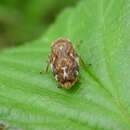Biology
provided by Arkive
Adults and nymphs are present between June and September (2). As with most bugs, individuals mate 'back to back' (4). All bugs have a type of insect development known as 'hemimetabolous development' in which there is no larval stage but a number of wingless nymphs instead which resemble the adult form (4). The nymphs of this species are protected by their covering of froth, which they create by blowing air into a fluid excreted from their anus. They feed on plant tissues below this protective covering, which also prevents them from drying out (2).
Conservation
provided by Arkive
Conservation action is not required for this common species.
Description
provided by Arkive
This small, common froghopper is variably patterned with brown, black and white (1). The wings are held like a tent over the body (2). It has recently been discovered that this froghopper is the champion jumper of the animal kingdom, able to jump 70 cm into the air. This is a greater height than the flea, yet the froghopper is much heavier, so it has the most impressive jumping style. The back legs used in jumping are so well-developed in this species that they trail behind it when it walks around. The jump is so powerful that in the initial stages a G-force of over 400 gravities is generated. This is truly phenomenal considering that an astronaut rocketing out into orbit experiences G-forces of 5-gravities (3). Young froghoppers, known as nymphs, develop in frothy clumps that are popularly known as cuckoospit (1). Like all bugs (Hemiptera), the froghopper has specialised sucking mouthparts, which in this species are used to feed on plant sap (4).
Habitat
provided by Arkive
Found in a wide range of habitats including parks, meadows and gardens on a variety of plants (1) (2).
Range
provided by Arkive
Common throughout Britain (1).
Threats
provided by Arkive
This species is not threatened (2).

